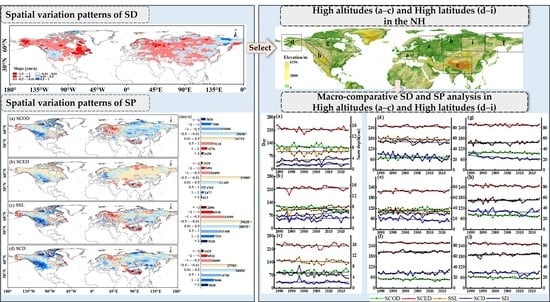Characteristics of Snow Depth and Snow Phenology in the High Latitudes and High Altitudes of the Northern Hemisphere from 1988 to 2018
Abstract
1. Introduction
2. Materials and Methods
2.1. Study Area
2.2. NHSD and GlobSnow Datasets
2.3. Auxiliary Datasets
2.3.1. Ground Observation Datasets
- (1)
- Quantity of data: if the quantity of data corresponding to a certain site in the study period was greater than or equal to 90% of the total data, these data were retained.
- (2)
- Distribution of data: data may have been unevenly distributed in certain years following step (1). Here, the data obtained in a given year at a certain site were divided into five-day groups, resulting in a total of 73 data groups; then, a judgment was made. If the number of valid values corresponding to each group was greater than or equal to four, the site was retained.
2.3.2. IMS and ERA Datasets
3. Methods
3.1. GlobSnow and NHSD Datasets Preprocessing
3.2. Definition of Snow Phenology
- (1)
- An SD greater than or equal to 3 cm was considered snow cover.
- (2)
- The first day on which the SD was greater than or equal to 3 cm and the length of continuous snow cover exceeded five days in the snow hydrological year was considered the snow cover onset day (SCOD).
- (3)
- The last day on which the SD was greater than or equal to 3 cm and the length of continuous coverage exceeded five days in the snow hydrological year was considered the snow cover end day (SCED).
- (4)
- The difference between the SCED and SCOD was regarded as the number for the snow season length (SSL).
- (5)
- The number of days with an SD greater than or equal to 3 cm on a given pixel in the snow hydrological year was considered the snow cover duration (SCD).
- (1)
- For the passive microwave dataset NHSD, the snow cover threshold is 3 cm due to uncertainties regarding shallow and thin snow measurements when using passive microwave snow cover inversion methods [58].
- (2)
- The model-simulation ERA-Interim dataset considers an area to be snow-covered when the snow depth is greater than 0 cm.
- (3)
- In the IMS dataset, pixel values of 4 or 165 are considered to be snow-covered [55].
- (4)
- The SD criterion for the ground observation datasets is 0.5 cm.
4. Results
4.1. Changes in Snow Depth
4.2. Changes in Snow Phenology
4.2.1. Spatial Distributions of SCOD, SCED, SSL and SCD
4.2.2. Interannual Variations in SCOD, SCED, SSL, and SCD
4.3. Characteristics of Snow Depth and Phenology in Typical Areas
- (1)
- Most typical areas were characterized by decreased SD, advanced SCOD and SCED, and insignificantly increased SCD and SSL trends.
- (2)
- The SCD and SSL were similar at high latitudes. The SSL was larger than the SCD at high altitudes; this may have been related to the presence of extensive transient snow cover in relatively low-elevation regions.
- (3)
- The general trends in SD, SSL, and SCD were consistent at high altitudes, while the trends in SSL and SCD at high latitudes were consistent. The interannual SD, SSL, and SCD fluctuations were similar in each typical area.
- (4)
- The SCOD variations influenced the changes in SCD and SSL. The SCD and SSL increased with an advanced SCOD and SCD, and the SSL decreased with a delayed SCOD.
5. Discussion
5.1. Comparisons with Ground Observation Datasets
5.2. Comparisons with the IMS and ERA-Interim Datasets
5.3. Comparisons with Existing Studies
6. Conclusions
- (1)
- Snow depth in the NH showed a significant decreasing trend from 1988 to 2018, with a rate of −0.55 cm/decade. Different snow depth changes were observed between the pre-2010 period and the post-2010 period. Changes in snow depth were insignificant at high altitudes, while significant decreases were found at high latitudes.
- (2)
- The NHSD dataset was shown to be capable of obtaining large-scale and long-term snow phenology information via comparisons with ground observation datasets, IMS, and ERA-Interim. The snow phenology parameters presented both latitudinal and vertical zonal distributions; in detail, the higher the latitude and altitude was, the earlier the snow cover onset day occurred, the later the snow cover end day occurred, and the longer the snow cover duration and snow season length were. The areas associated with an earlier snow cover onset day were 10.47% larger than the delayed areas in the NH. The snow cover onset day occurred earlier at high altitudes except for the Qinghai–Tibet Plateau, as it did at most of the high latitudes. The areas associated with an advanced snow cover end day were 22.52% larger than the delayed areas in the NH. An advanced snow cover end day occurred in most typical areas.
- (3)
- Most typical areas were characterized by a decreased snow depth, an advanced snow cover onset day, an insignificantly advanced snow cover end day, and insignificant increasing trends in snow cover duration and snow season length. The snow cover duration and snow season length values were similar at high latitudes, while the snow season length value was larger than the snow cover duration value at high altitudes. The snow depth exhibited similar interannual fluctuation characteristics as snow cover duration and snow season length in each typical area. In addition, we found that the snow cover duration and snow season length increased and decreased corresponding to an advanced or delayed snow cover onset day.
Author Contributions
Funding
Data Availability Statement
Acknowledgments
Conflicts of Interest
Appendix A

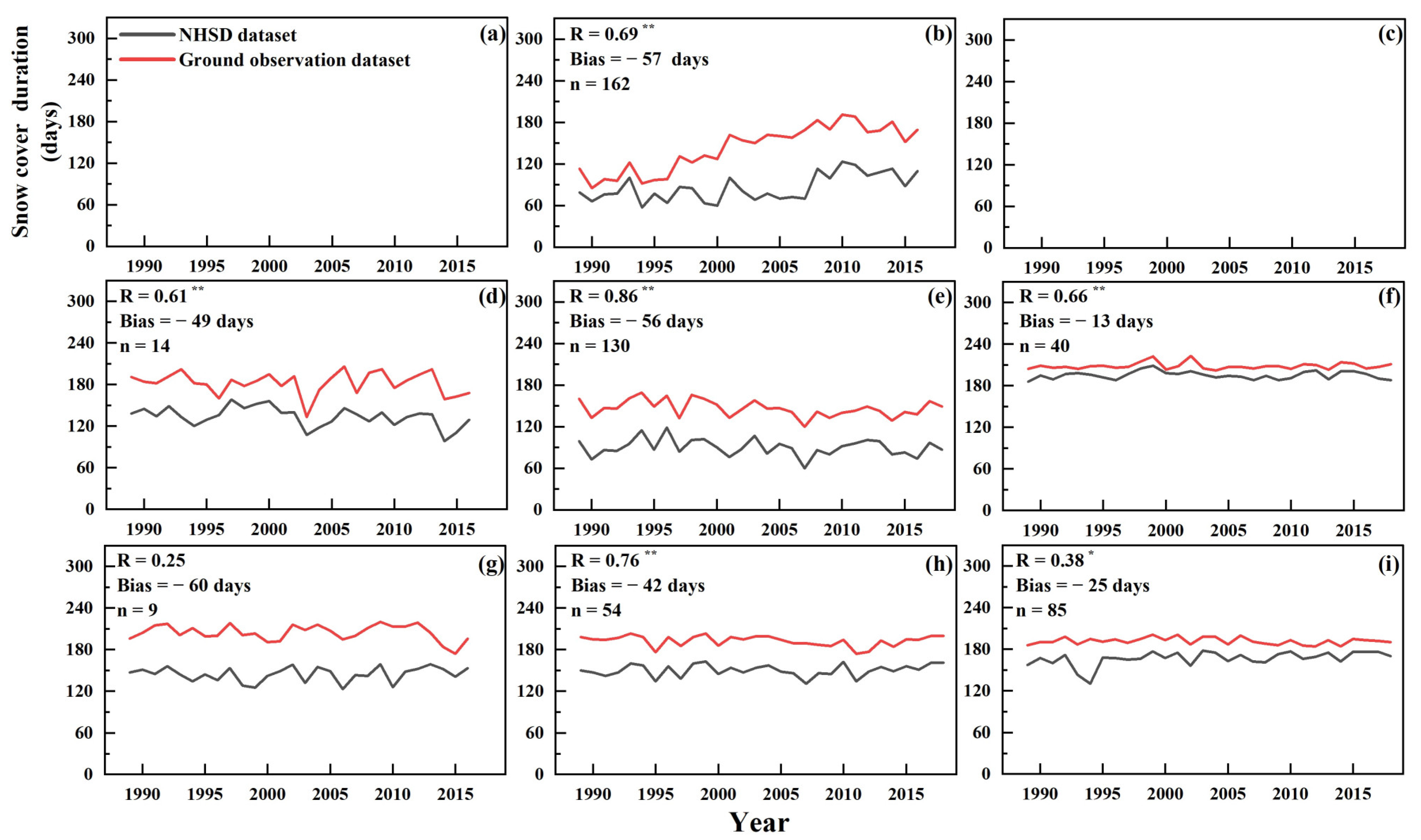
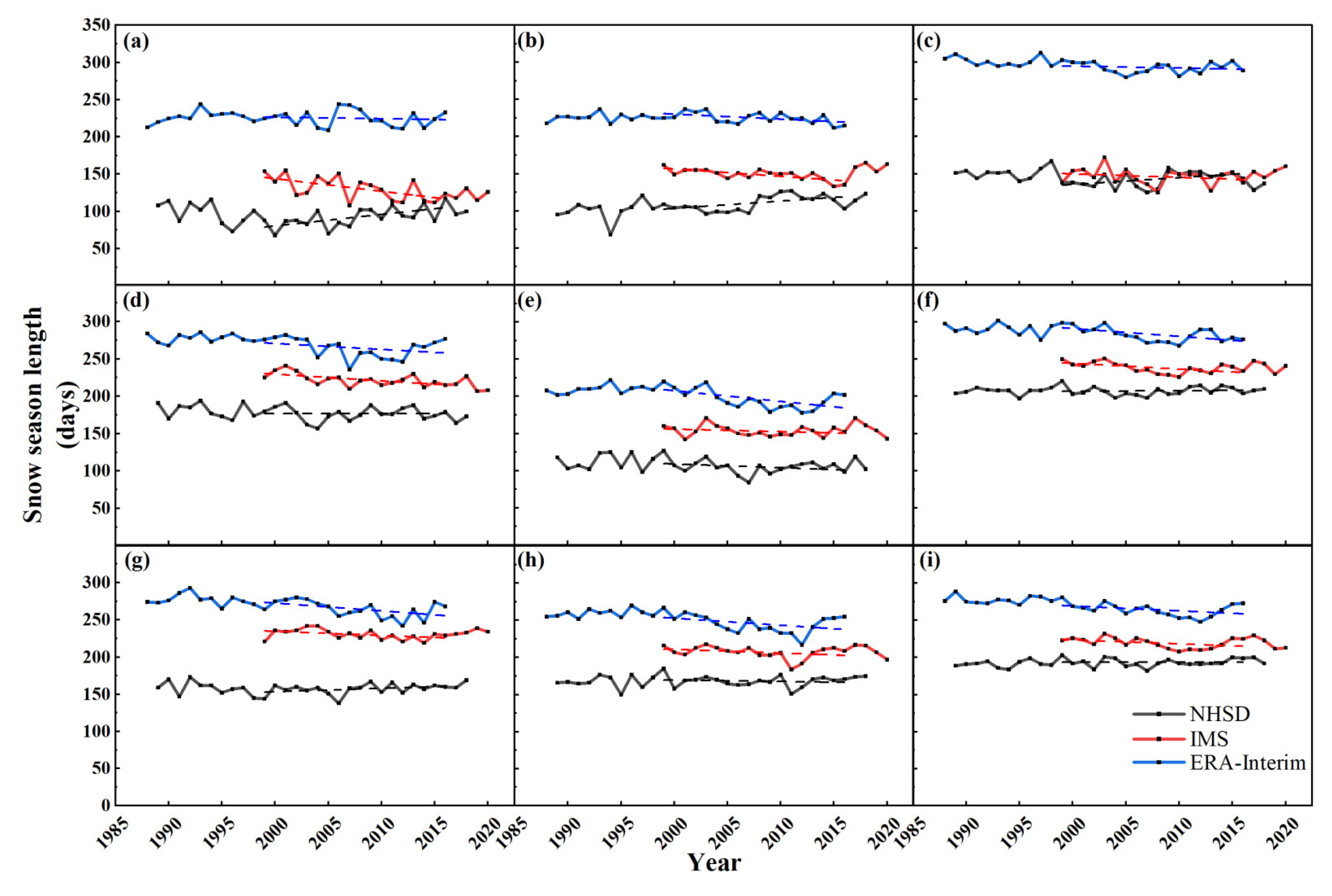
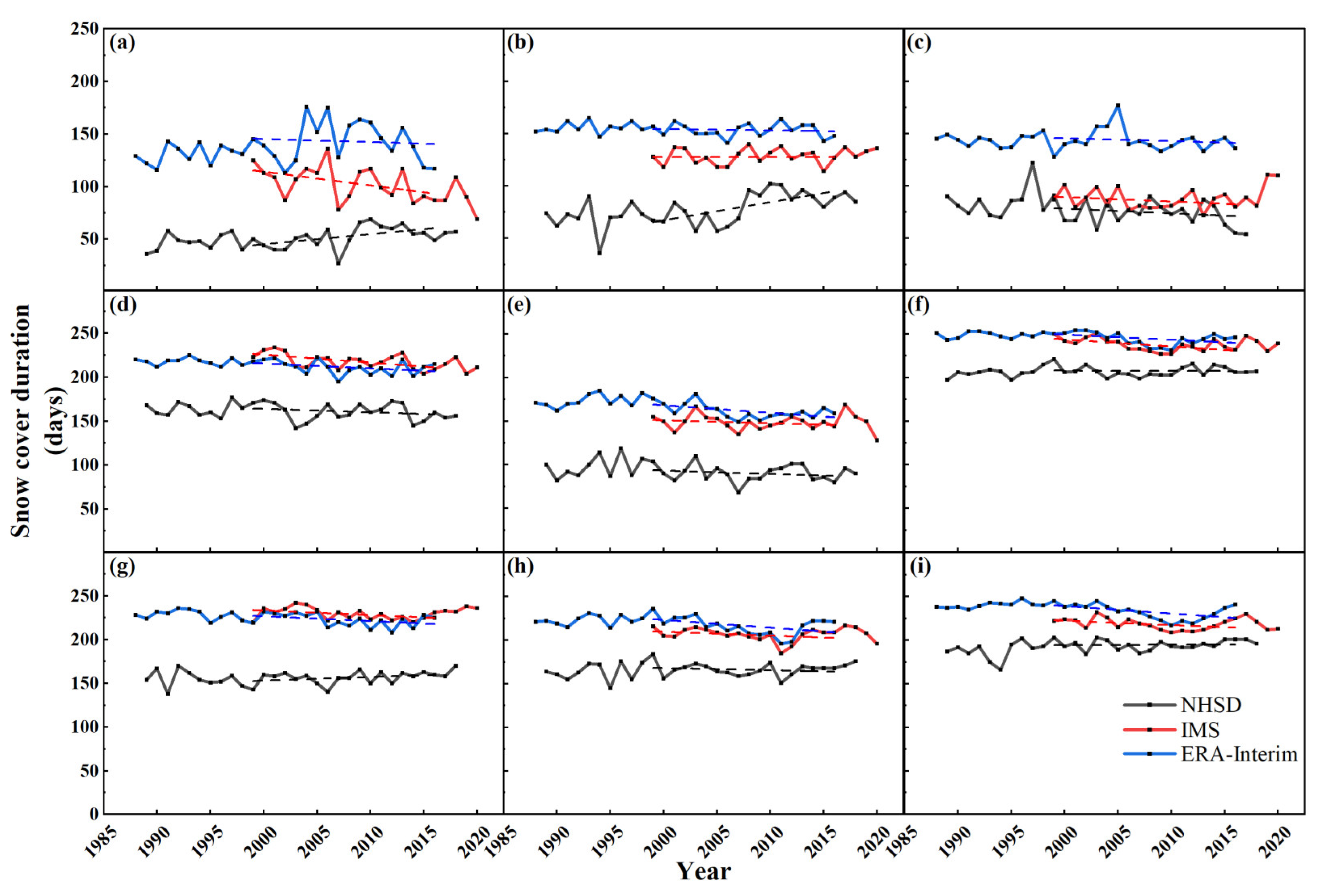
References
- Bormann, K.J.; Brown, R.D.; Derksen, C.; Painter, T.H. Estimating snow-cover trends from space. Nat. Clim. Change 2018, 8, 923–927. [Google Scholar] [CrossRef]
- Flanner, M.G.; Shell, K.M.; Barlage, M.; Perovich, D.K.; Tschudi, M.A. Radiative forcing and albedo feedback from the Northern Hemisphere cryosphere between 1979 and 2008. Nat. Geosci. 2011, 4, 151–155. [Google Scholar] [CrossRef]
- Immerzeel, W.W.; van Beek, L.P.H.; Bierkens, M.F.P. Climate Change Will Affect the Asian Water Towers. Science 2010, 328, 1382–1385. [Google Scholar] [CrossRef] [PubMed]
- Barnett, T.P.; Adam, J.C.; Lettenmaier, D.P. Potential impacts of a warming climate on water availability in snow-dominated regions. Nature 2005, 438, 303–309. [Google Scholar] [CrossRef]
- Déry, S.J.; Brown, R.D. Recent Northern Hemisphere snow cover extent trends and implications for the snow-albedo feedback. Geophys. Res. Lett. 2007, 34, 2–7. [Google Scholar] [CrossRef]
- Sturm, M.; Goldstein, M.A.; Parr, C. Water and life from snow: A trillion dollar science question. Water Resour. Res. 2017, 53, 3534–3544. [Google Scholar] [CrossRef]
- Fugazza, D.; Manara, V.; Senese, A.; Diolaiuti, G.; Maugeri, M. Snow Cover Variability in the Greater Alpine Region in the MODIS Era (2000–2019). Remote Sens. 2021, 13, 2945. [Google Scholar] [CrossRef]
- Deng, J.; Che, T.; Xiao, C.; Wang, S.; Dai, L.; Meerzhan, A. Suitability analysis of ski areas in China: An integrated study based on natural and socioeconomic conditions. Cryosphere 2019, 13, 2149–2167. [Google Scholar] [CrossRef]
- Silberman, J.A.; Rees, P.W. Reinventing mountain settlements: A GIS model for identifying possible ski towns in the US Rocky Mountains. Appl. Geogr. 2010, 30, 36–49. [Google Scholar] [CrossRef]
- Lin, Y.; Jiang, M. Maximum temperature drove snow cover expansion from the Arctic, 2000–2008. Sci. Rep. 2017, 7, 15090. [Google Scholar] [CrossRef]
- Ke, C.; Li, X.; Xie, H.; Ma, D.; Liu, X.; Kou, C. Variability in snow cover phenology in China from 1952 to 2010. Hydrol. Earth Syst. Sci. 2016, 20, 755–770. [Google Scholar] [CrossRef]
- Liston, G.E.; Hiemstra, C.A. The Changing Cryosphere: Pan-Arctic Snow Trends (1979–2009). J. Clim. 2011, 24, 5691–5712. [Google Scholar] [CrossRef]
- Brown, R.D.; Robinson, D.A. Northern Hemisphere spring snow cover variability and change over 1922-2010 including an assessment of uncertainty. Cryosphere 2011, 5, 219–229. [Google Scholar] [CrossRef]
- Smith, N.V.; Saatchi, S.S.; Randerson, J.T. Trends in high northern latitude soil freeze and thaw cycles from 1988 to 2002. J. Geophys. Res. Atmos. 2004, 109, 1–14. [Google Scholar] [CrossRef]
- Pepin, N.; Bradley, R.S.; Diaz, H.F.; Baraer, M.; Caceres, E.B.; Forsythe, N.; Fowler, H.; Greenwood, G.; Hashmi, M.Z.; Liu, X.D.; et al. Elevation-dependent warming in mountain regions of the world. Nat. Clim. Change 2015, 5, 424–430. [Google Scholar] [CrossRef]
- Bongaarts, J. Intergovernmental Panel on Climate Change Special Report on Global Warming of 1.5 °C; IPCC: Geneva, Switzerland, 2018. [Google Scholar]
- Kohler, T.; Wehrli, A.; Jurek, M. Mountains and Climate Chance: A Global Concern; Geographica Bernensia: Bern, Switzerland, 2014. [Google Scholar]
- Kohler, T.; Giger, M.; Hurni, H.; Ott, C.; Wiesmann, U.; von Dach, S.W.; Maselli, D. Mountains and Climate Change: A Global Concern. Mt. Res. Dev. 2010, 30, 53–55. [Google Scholar] [CrossRef]
- Guo, H.; Li, X.; Qiu, Y. Comparison of global change at the Earth’s three poles using spaceborne Earth observation. Sci. Bull. 2020, 65, 1320–1323. [Google Scholar] [CrossRef]
- Peng, S.; Piao, S.; Ciais, P.; Friedlingstein, P.; Zhou, L.; Wang, T. Changes in snow phenology and its potential feedback to temperature in the Northern Hemisphere over the last three decades. Environ. Res. Lett. 2013, 8, 14008. [Google Scholar] [CrossRef]
- Zhong, X.; Zhang, T.; Kang, S.; Wang, K.; Zheng, L.; Hu, Y.; Wang, H. Spatiotemporal variability of snow depth across the Eurasian continent from 1966 to 2012. Cryosphere 2018, 12, 227–245. [Google Scholar] [CrossRef]
- Zhong, X.; Zhang, T.; Kang, S.; Wang, J. Spatiotemporal variability of snow cover timing and duration over the Eurasian continent during 1966–2012. Sci. Total Environ. 2021, 750, 141670. [Google Scholar] [CrossRef]
- Derksen, C.; Burgess, D.; Duguay, C.; Howell, S.; Mudryk, L.; Smith, S.; Thackeray, C.; Kirchmeier-Young, M. Changes in Snow, Ice, and Permafrost across Canada. In Canada’s Changing Climate Report 2019; Bush, E., Lemmen, D.S., Eds.; Government of Canada: Ottawa, Canada, 2019; Chapter 5; pp. 194–260. Available online: https://changingclimate.ca/CCCR2019/ (accessed on 9 July 2022).
- Mote, P.W.; Li, S.H.; Lettenmaier, D.P.; Xiao, M.; Engel, R. Dramatic declines in snowpack in the western US. NPJ Clim. Atmos. Sci. 2018, 1, 1–6. [Google Scholar] [CrossRef]
- Hall, D.K.; Riggs, G.A.; Salomonson, V.V.; DiGirolamo, N.E.; Bayr, K.J. MODIS snow-cover products. Remote Sens. Environ. 2002, 83, 181–194. [Google Scholar] [CrossRef]
- Zhang, N.; Fan, X.; Zhu, J. Spatial and Temporal Variation of Snow Cover over Northern Hemisphere Using MODIS Snow Products. Remote Sens. Inf. 2012, 27, 28–34. (In Chinese) [Google Scholar]
- Wang, Y.; Huang, X.; Liang, H.; Sun, Y.; Feng, Q.; Liang, T. Tracking Snow Variations in the Northern Hemisphere Using Multi-Source Remote Sensing Data (2000–2015). Remote Sens. 2018, 10, 136. [Google Scholar] [CrossRef]
- Sun, Y.; Zhang, T.; Liu, Y.; Zhao, W.; Huang, X. Assessing Snow Phenology over the Large Part of Eurasia Using Satellite Observations from 2000 to 2016. Remote Sens. 2020, 12, 2060. [Google Scholar] [CrossRef]
- Huang, X.; Deng, J.; Ma, X.; Wang, Y.; Feng, Q.; Hao, X.; Liang, T. Spatiotemporal dynamics of snow cover based on multi-source remote sensing data in China. Cryosphere 2016, 10, 2453–2463. [Google Scholar] [CrossRef]
- Hammond, J.C.; Saavedra, F.A.; Kampf, S.K. Global snow zone maps and trends in snow persistence 2001–2016. Int. J. Climatol. 2018, 38, 4369–4383. [Google Scholar] [CrossRef]
- Tekeli, A.E.; Akyürek, Z.; Arda Şorman, A.; Şensoy, A.; Ünal Şorman, A. Using MODIS snow cover maps in modeling snowmelt runoff process in the eastern part of Turkey. Remote Sens. Environ. 2005, 97, 216–230. [Google Scholar] [CrossRef]
- Notarnicola, C. Hotspots of snow cover changes in global mountain regions over 2000–2018. Remote Sens. Environ. 2020, 243, 111781. [Google Scholar] [CrossRef]
- Wang, X.; Wu, C.; Wang, H.; Gonsamo, A.; Liu, Z. No evidence of widespread decline of snow cover on the Tibetan Plateau over 2000–2015. Sci. Rep. 2017, 7, 14645. [Google Scholar] [CrossRef]
- Mudryk, L.R.; Derksen, C.; Kushner, P.J.; Brown, R. Characterization of Northern Hemisphere Snow Water Equivalent Datasets, 1981–2010. J. Clim. 2015, 28, 8037–8051. [Google Scholar] [CrossRef]
- Parker, W.S. Reanalyses and Observations: What’s the Difference? Bull. Am. Meteorol. Soc. 2016, 97, 1565–1572. [Google Scholar] [CrossRef]
- Snauffer, A.M.; Hsieh, W.W.; Cannon, A.J.; Schnorbus, M.A. Improving gridded snow water equivalent products in British Columbia, Canada: Multi-source data fusion by neural network models. Cryosphere 2018, 12, 891–905. [Google Scholar] [CrossRef]
- Dai, L.; Che, T. Estimating snow depth or snow water equivalent from space. Sci.Cold Arid Reg. 2022, 14, 79–90. [Google Scholar] [CrossRef]
- Li, Z.; Liu, J.; Tian, B. Spatial and temporal series analysis of snow cover extent and snow water equivalent for satellite passive microwave data in the northern hemisphere (1978–2010). In Proceedings of the IEEE International Geoscience and Remote Sensing Symposium (IGARSS), Munich, Germany, 22–27 July 2012; pp. 4871–4874. [Google Scholar]
- Xiao, X.; Zhang, T.; Zhong, X.; Li, X. Spatiotemporal Variation of Snow Depth in the Northern Hemisphere from 1992 to 2016. Remote Sens. 2020, 12, 2728. [Google Scholar] [CrossRef]
- Pulliainen, J.; Luojus, K.; Derksen, C.; Mudryk, L.; Lemmetyinen, J.; Salminen, M.; Ikonen, J.; Takala, M.; Cohen, J.; Smolander, T.; et al. Patterns and trends of Northern Hemisphere snow mass from 1980 to 2018. Nature 2020, 581, 294–298. [Google Scholar] [CrossRef]
- Xiao, L.; Che, T.; Dai, L. Evaluation of Remote Sensing and Reanalysis Snow Depth Datasets over the Northern Hemisphere during 1980–2016. Remote Sens. 2020, 12, 3253. [Google Scholar] [CrossRef]
- Luojus, K.; Pulliainen, J.; Takala, M.; Lemmetyinen, J.; Derksen, C.; Metsamaki, S.; Bojkov, B. Investigating hemispherical trends in snow accumulation using globsnow snow water equivalent data. In Proceedings of the IEEE International Geoscience and Remote Sensing Symposium (IGARSS), Vancouver, BC, Canada, 24–29 July 2011; pp. 3772–3774. [Google Scholar]
- Jeong, D.I.; Sushama, L.; Naveed Khaliq, M. Attribution of spring snow water equivalent (SWE) changes over the northern hemisphere to anthropogenic effects. Clim. Dyn. 2016, 48, 3645–3658. [Google Scholar] [CrossRef]
- Mudryk, L.R.; Kushner, P.J.; Derksen, C. Interpreting observed northern hemisphere snow trends with large ensembles of climate simulations. Clim. Dyn. 2014, 43, 345–359. [Google Scholar] [CrossRef]
- Zhu, L.; Ma, G.; Zhang, Y.; Wang, J.; Tian, W.; Kan, X. Accelerated decline of snow cover in China from 1979 to 2018 observed from space. Sci. Total Environ. 2022, 814, 152491. [Google Scholar] [CrossRef]
- Matiu, M.; Crespi, A.; Bertoldi, G.; Carmagnola, C.M.; Marty, C.; Morin, S.; Schoner, W.; Berro, D.C.; Chiogna, G.; De Gregorio, L.; et al. Observed snow depth trends in the European Alps: 1971 to 2019. Cryosphere 2021, 15, 1343–1382. [Google Scholar] [CrossRef]
- Takala, M.; Luojus, K.; Pulliainen, J.; Derksen, C.; Lemmetyinen, J.; Karna, J.P.; Koskinen, J.; Bojkov, B. Estimating northern hemisphere snow water equivalent for climate research through assimilation of space-borne radiometer data and ground-based measurements. Remote Sens. Environ. 2011, 115, 3517–3529. [Google Scholar] [CrossRef]
- Pulliainen, J. Mapping of snow water equivalent and snow depth in boreal and sub-arctic zones by assimilating space-borne microwave radiometer data and ground-based observations. Remote Sens. Environ. 2006, 101, 257–269. [Google Scholar] [CrossRef]
- Che, T.; Li, X.; Jin, R.; Armstrong, R.; Zhang, T. Snow depth derived from passive microwave remote-sensing data in China. Ann. Glaciol. 2008, 49, 145–154. [Google Scholar] [CrossRef]
- Chang, A.T.C.; Foster, J.L.; Hall, D.K. Nimbus-7 SMMR derived GlobSnow snow cover parameters. Ann. Glaciol. 1987, 9, 39–44. [Google Scholar] [CrossRef]
- Dai, L.; Che, T.; Ding, Y. Inter-Calibrating SMMR, SSM/I and SSMI/S Data to Improve the Consistency of Snow-Depth Products in China. Remote Sens. 2015, 7, 7212–7230. [Google Scholar] [CrossRef]
- Arino, O.; Ramos Perez, J.J.; Kalogirou, V.; Bontemps, S.; Defourny, P.; Van Bogaert, E. Global Land Cover Map For 2009 (GlobCover 2009); USAID: Washington, DC, USA, 2012. [Google Scholar]
- Xiao, L. Spatial and Temporal Consistency and Accuracy Assessment of Snow Depth Data in the Northern Hemisphere and Its Fusion; University of Chinese Academy of Sciences (Northwest Institute of Ecological and Environmental Resources, Chinese Academy of Sciences): Beijing, China, 2019. [Google Scholar]
- Menne, M.J.; Durre, I.; Vose, R.S.; Gleason, B.E.; Houston, T.G. An overview of the global historical climatology network-daily database. J. Atmos. Oceanic Technol. 2012, 29, 897–910. [Google Scholar] [CrossRef]
- Helfrich, S.R.; McNamara, D.; Ramsay, B.H.; Baldwin, T.; Kasheta, T. Enhancements to, and forthcoming developments in the Interactive Multisensor Snow and Ice Mapping System (IMS). Hydrol. Process. 2007, 21, 1576–1586. [Google Scholar] [CrossRef]
- Ramsay, B.H. The interactive multisensor snow and ice mapping system. Hydrol. Processes 1998, 12, 1537–1546. [Google Scholar] [CrossRef]
- Dee, D.P.; Uppala, S.M.; Simmons, A.J.; Berrisford, P.; Poli, P.; Kobayashi, S.; Andrae, U.; Balmaseda, M.A.; Balsamo, G.; Bauer, P.; et al. The ERA-Interim reanalysis: Configuration and performance of the data assimilation system. Q. J. R. Meteorolog. Soc. 2011, 137, 553–597. [Google Scholar] [CrossRef]
- Kelly, R.E. The AMSR-E Snow Depth Algorithm: Description and Initial Results. J. Remote Sens. Soc. Jpn. 2009, 29, 307–317. [Google Scholar]
- Saavedra, F.A.; Kampf, S.K.; Fassnacht, S.R.; Sibold, J.S. Changes in Andes snow cover from MODIS data, 2000–2016. Cryosphere 2018, 12, 1027–1046. [Google Scholar] [CrossRef]
- Fassnacht, S.R.; Cherry, M.L.; Venable, N.B.H.; Saavedra, F. Snow and albedo climate change impacts across the United States Northern Great Plains. Cryosphere 2016, 10, 329–339. [Google Scholar] [CrossRef]
- Frei, A.; Tedesco, M.; Lee, S.; Foster, J.; Hall, D.K.; Kelly, R.; Robinson, D.A. A review of global satellite-derived snow products. Adv. Space Res. 2012, 50, 1007–1029. [Google Scholar] [CrossRef]
- Foster, J.L.; Sun, C.J.; Walker, J.P.; Kelly, R.; Chang, A.; Dong, J.R.; Powell, H. Quantifying the uncertainty in passive microwave snow water equivalent observations. Remote Sens. Environ. 2005, 94, 187–203. [Google Scholar] [CrossRef]
- Chen, C.; Lakhankar, T.; Romanov, P.; Helfrich, S.; Powell, A.; Khanbilvardi, R. Validation of NOAA-Interactive Multisensor Snow and Ice Mapping System (IMS) by Comparison with Ground-Based Measurements over Continental United States. Remote Sens. 2012, 4, 1134–1145. [Google Scholar] [CrossRef]
- Chen, X.; Yang, Y.; Ma, Y.; Li, H. Distribution and Attribution of Terrestrial Snow Cover Phenology Changes over the Northern Hemisphere during 2001–2020. Remote Sens. 2021, 13, 1843. [Google Scholar] [CrossRef]
- Che, T.; Hao, X.; Dai, L.; Li, H.; Huang, X.; Xiao, L. Snow Cover Variation and Its Impacts over the Qinghai-Tibet Plateau. Bull. Chin. Acad. Sci. 2019, 34, 1247–1253. [Google Scholar]
- Huang, X.; Deng, J.; Wang, W.; Feng, Q.; Liang, T. Impact of climate and elevation on snow cover using integrated remote sensing snow products in Tibetan Plateau. Remote Sens. Environ. 2017, 190, 274–288. [Google Scholar] [CrossRef]
- Qiao, D.; Wang, N.; Li, Z.; Zhou, J.; Fu, X. Spatio-temporal changes of snow phenology in the Qinghai-Tibetan Plateau during the hydrological year of 1980–2009. Progress. Inquisitiones Mutat. Clim. 2018, 14, 137–143. (In Chinese) [Google Scholar]
- Beniston, M.; Farinotti, D.; Stoffel, M.; Andreassen, L.M.; Coppola, E.; Eckert, N.; Fantini, A.; Giacona, F.; Hauck, C.; Huss, M.; et al. The European mountain cryosphere: A review of its current state, trends, and future challenges. Cryosphere 2018, 12, 759–794. [Google Scholar] [CrossRef]
- Dyrrdal, A.V.; Saloranta, T.; Skaugen, T.; Stranden, H.B. Changes in snow depth in Norway during the period 1961–2010. Hydrol. Res. 2013, 44, 169–179. [Google Scholar] [CrossRef]
- Bocchiola, D.; Diolaiuti, G. Evidence of climate change within the Adamello Glacier of Italy. Theor. Appl. Climatol. 2010, 100, 351–369. [Google Scholar] [CrossRef]
- Marty, C.; Tilg, A.M.; Jonas, T. Recent Evidence of Large-Scale Receding Snow Water Equivalents in the European Alps. J. Hydrometeorol. 2017, 18, 1021–1031. [Google Scholar] [CrossRef]
- Brown, R.D.; Smith, C.; Derksen, C.; Mudryk, L. Canadian In Situ Snow Cover Trends for 1955–2017 Including an Assessment of the Impact of Automation. Atmos. Ocean 2021, 59, 77–92. [Google Scholar] [CrossRef]
- Henderson, G.R.; Peings, Y.; Furtado, J.C.; Kushner, P.J. Snow-atmosphere coupling in the Northern Hemisphere. Nat. Clim. Change 2018, 8, 954–963. [Google Scholar] [CrossRef]


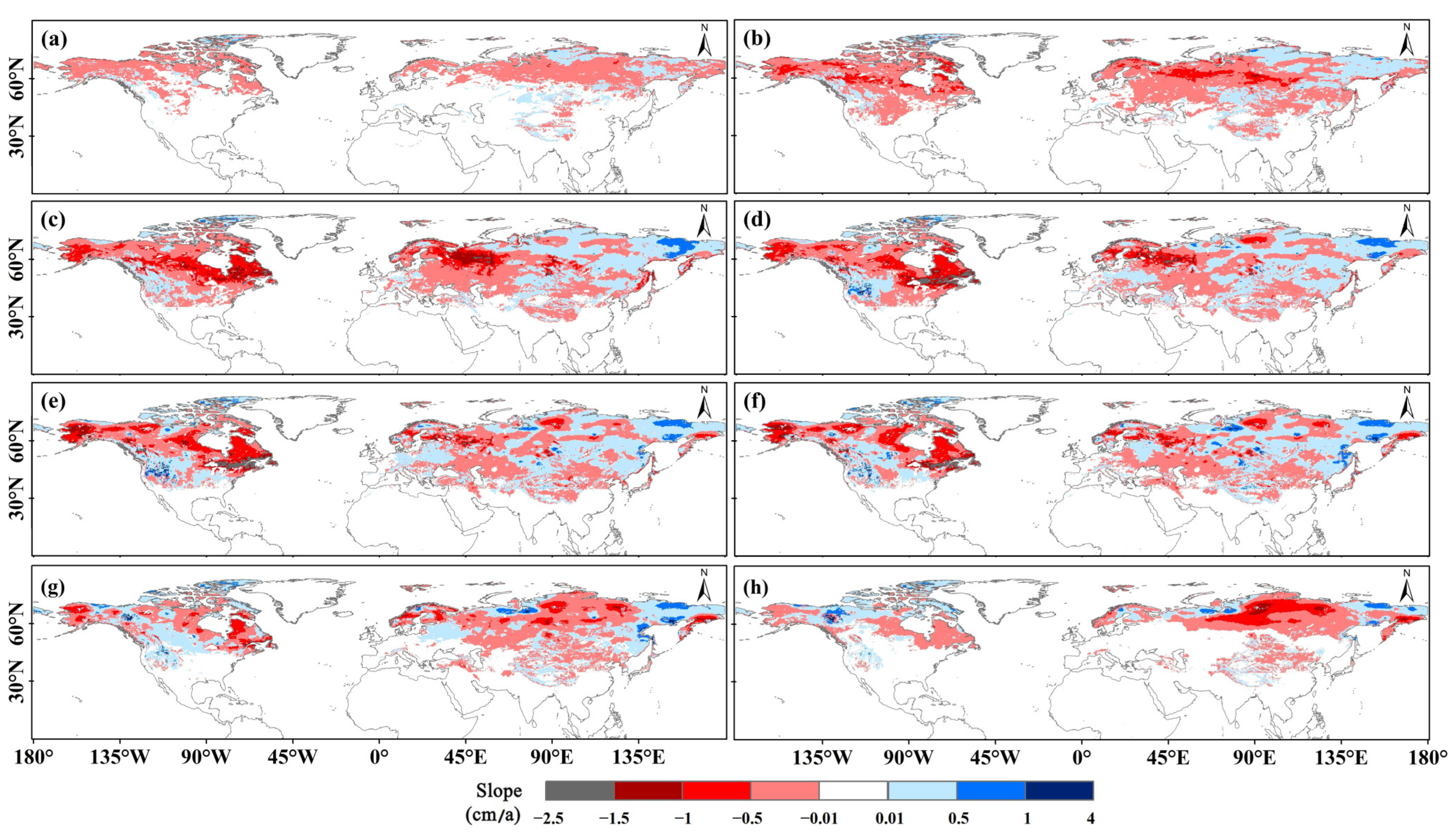
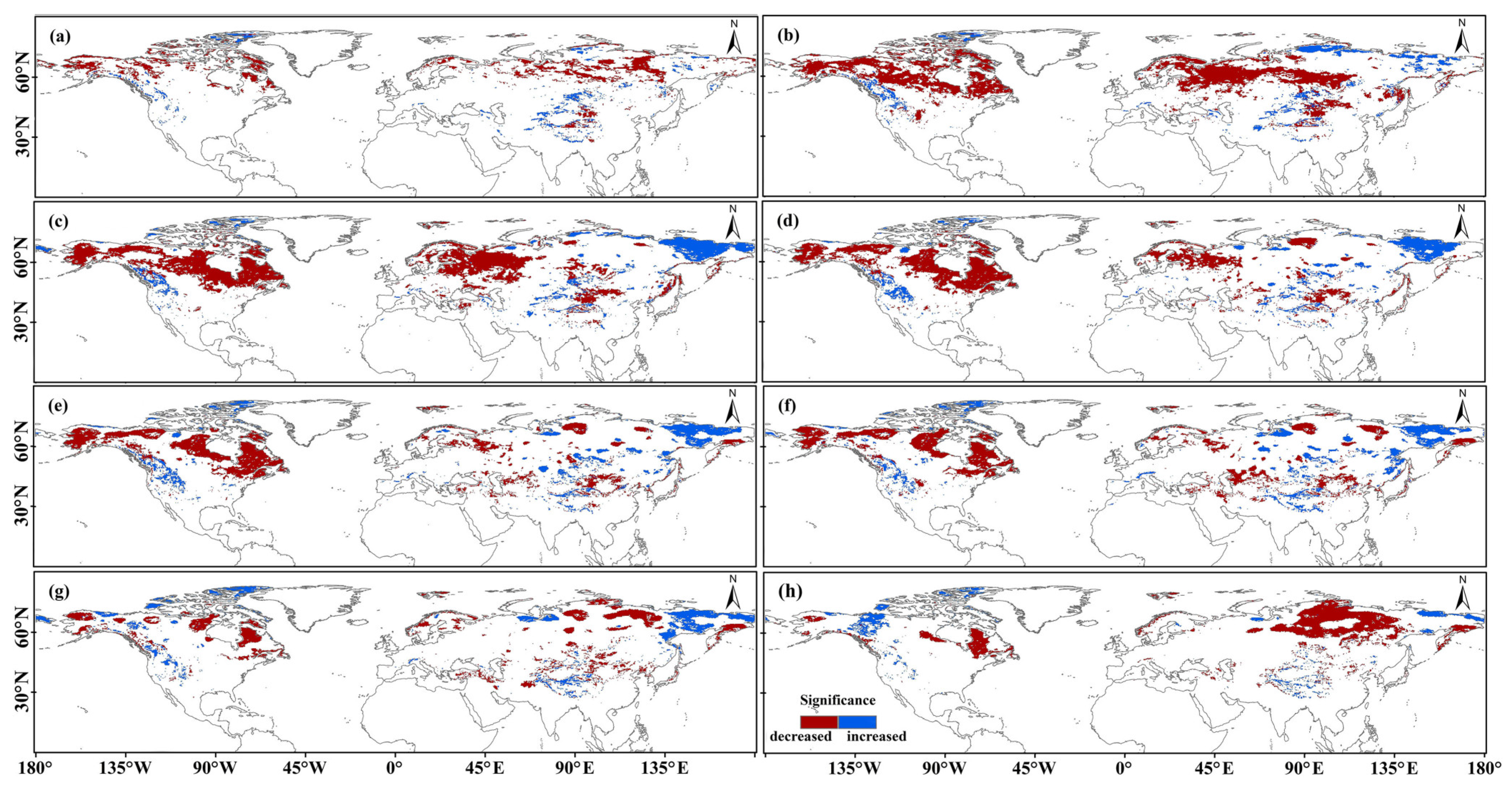
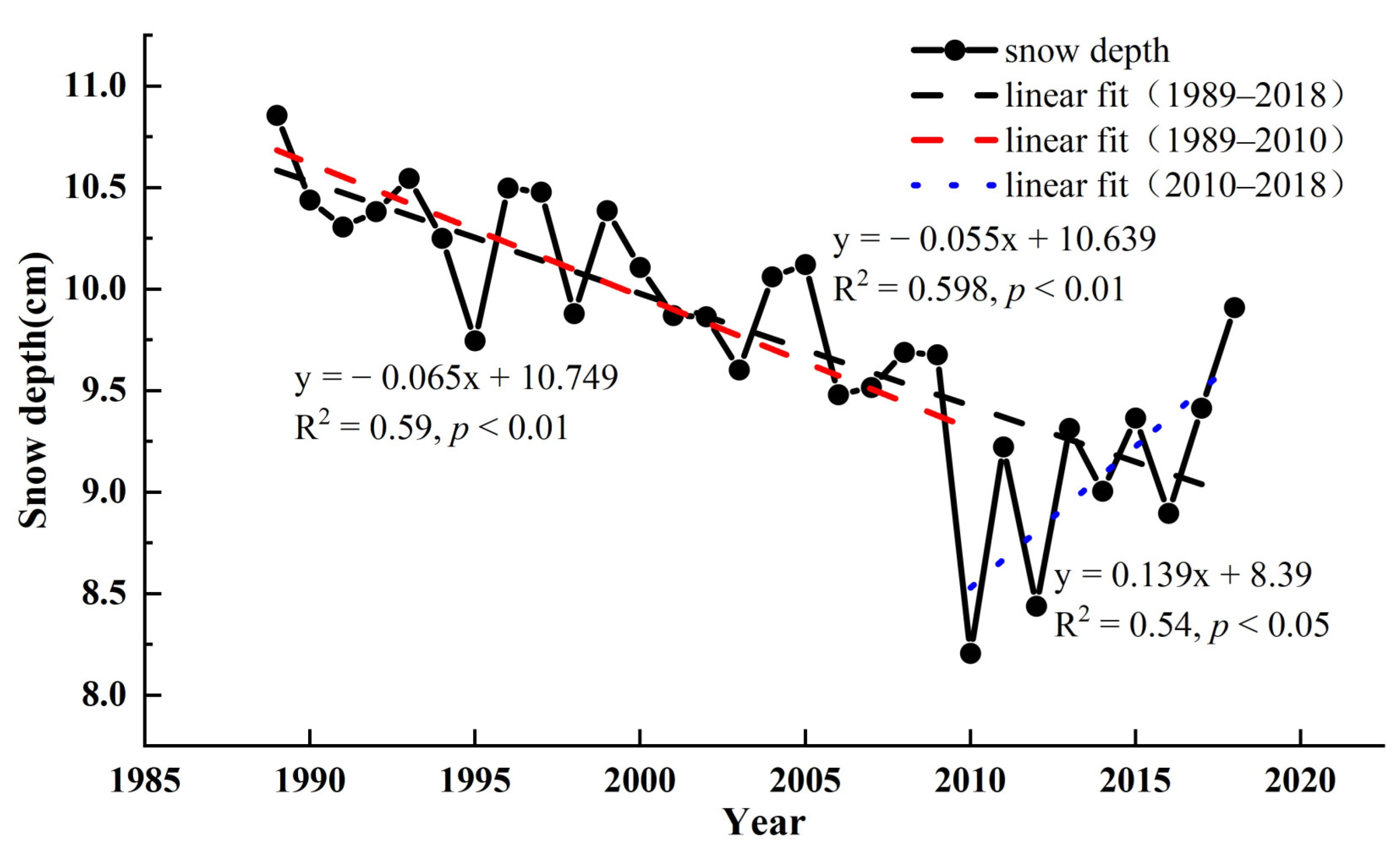
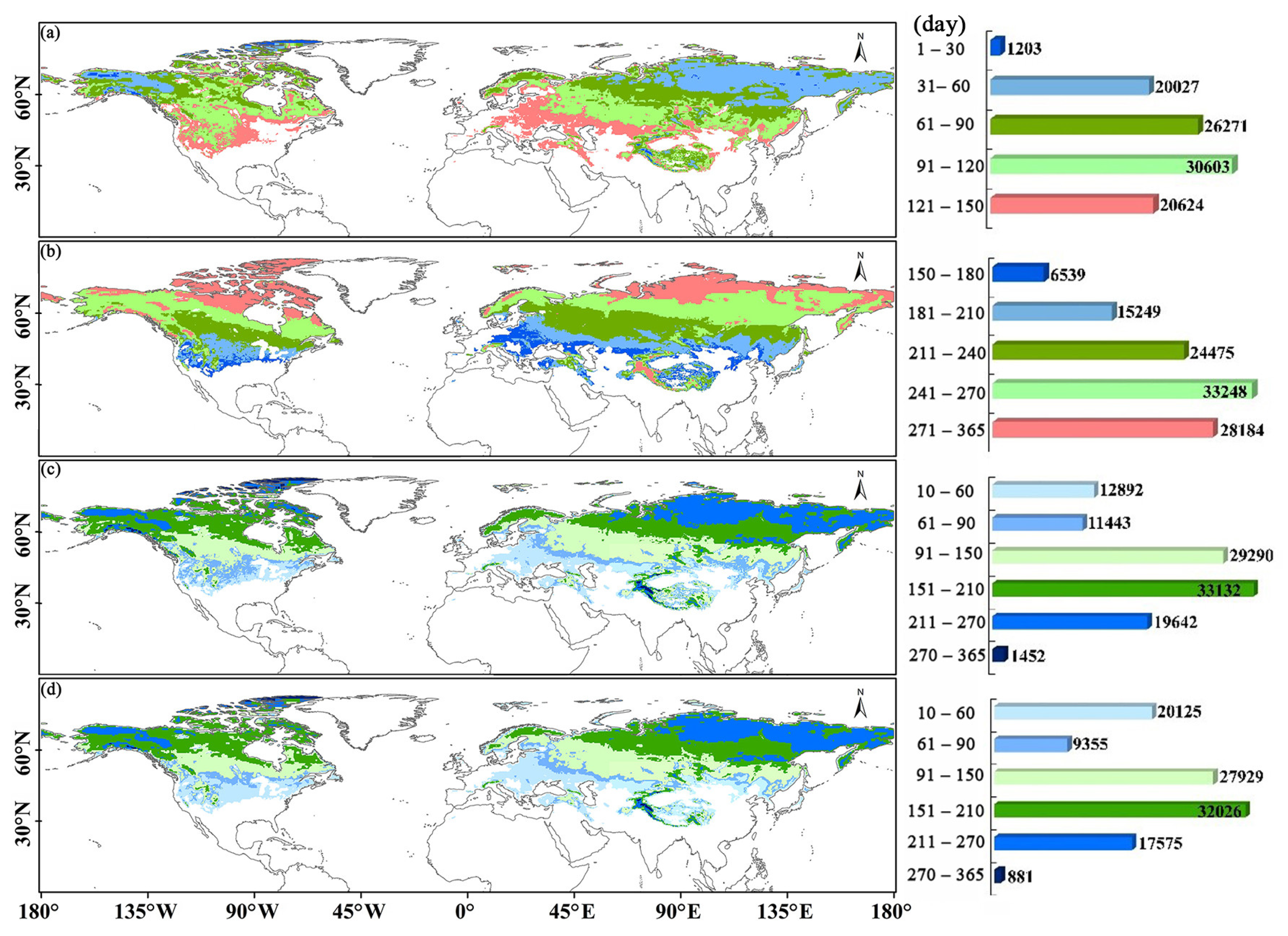
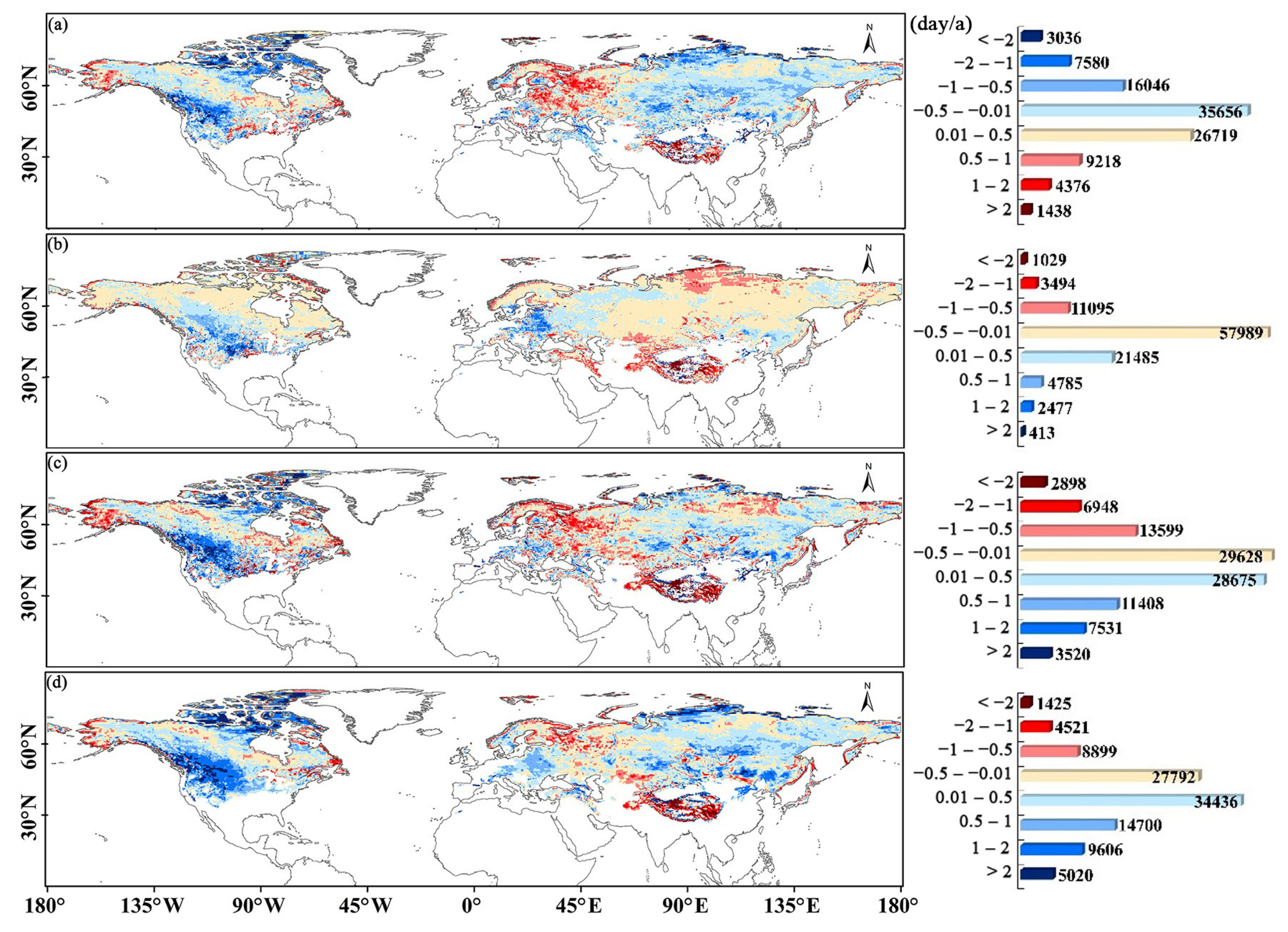

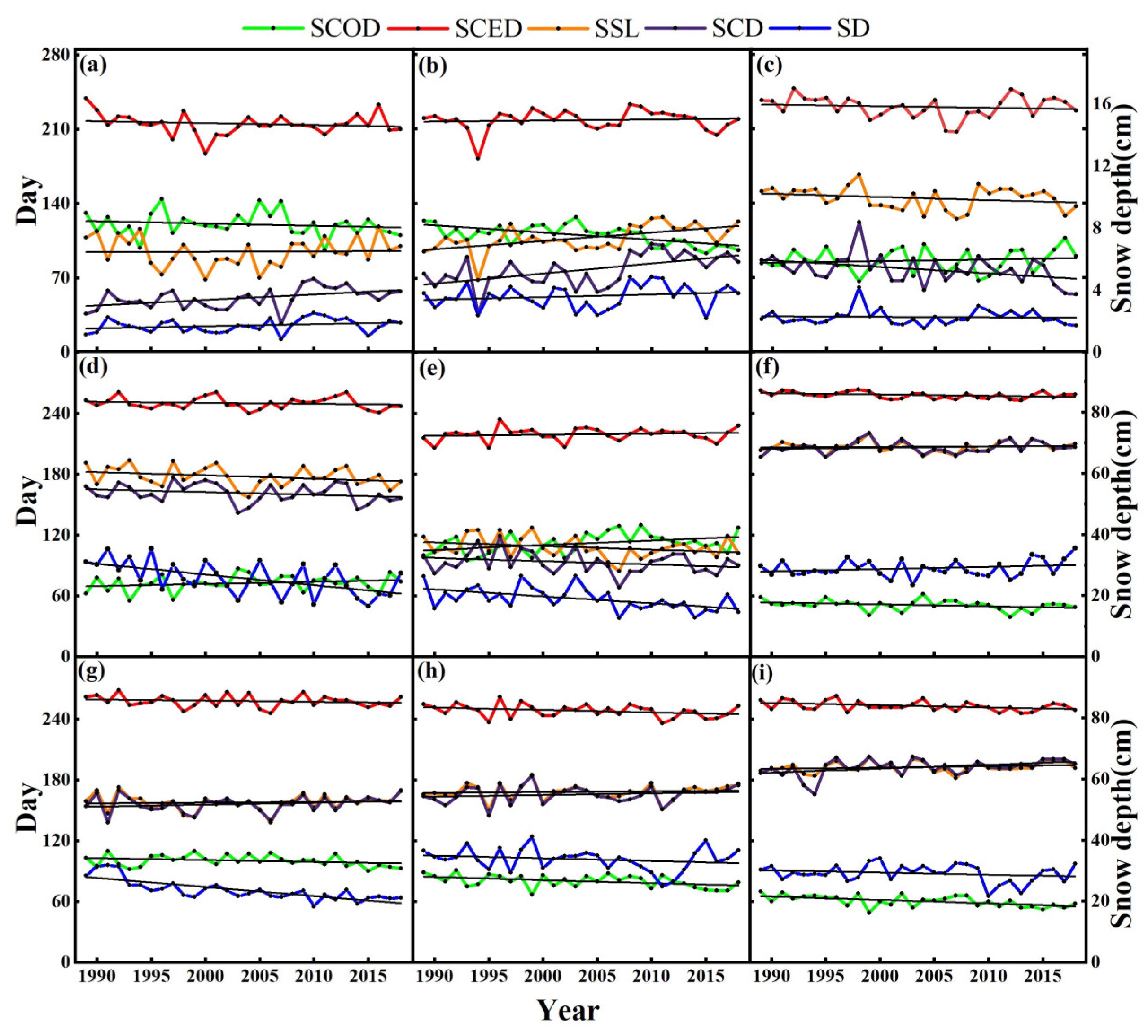
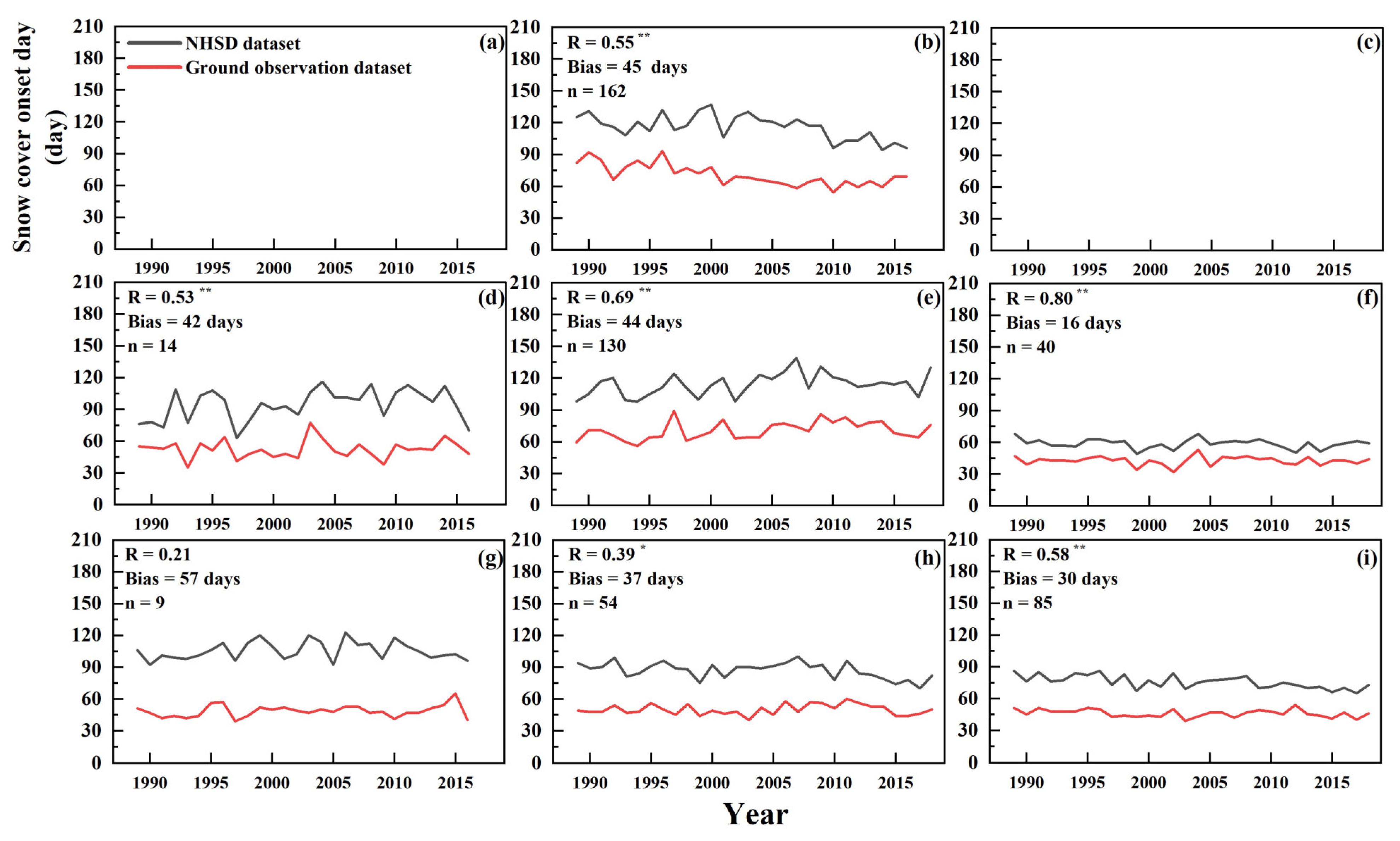
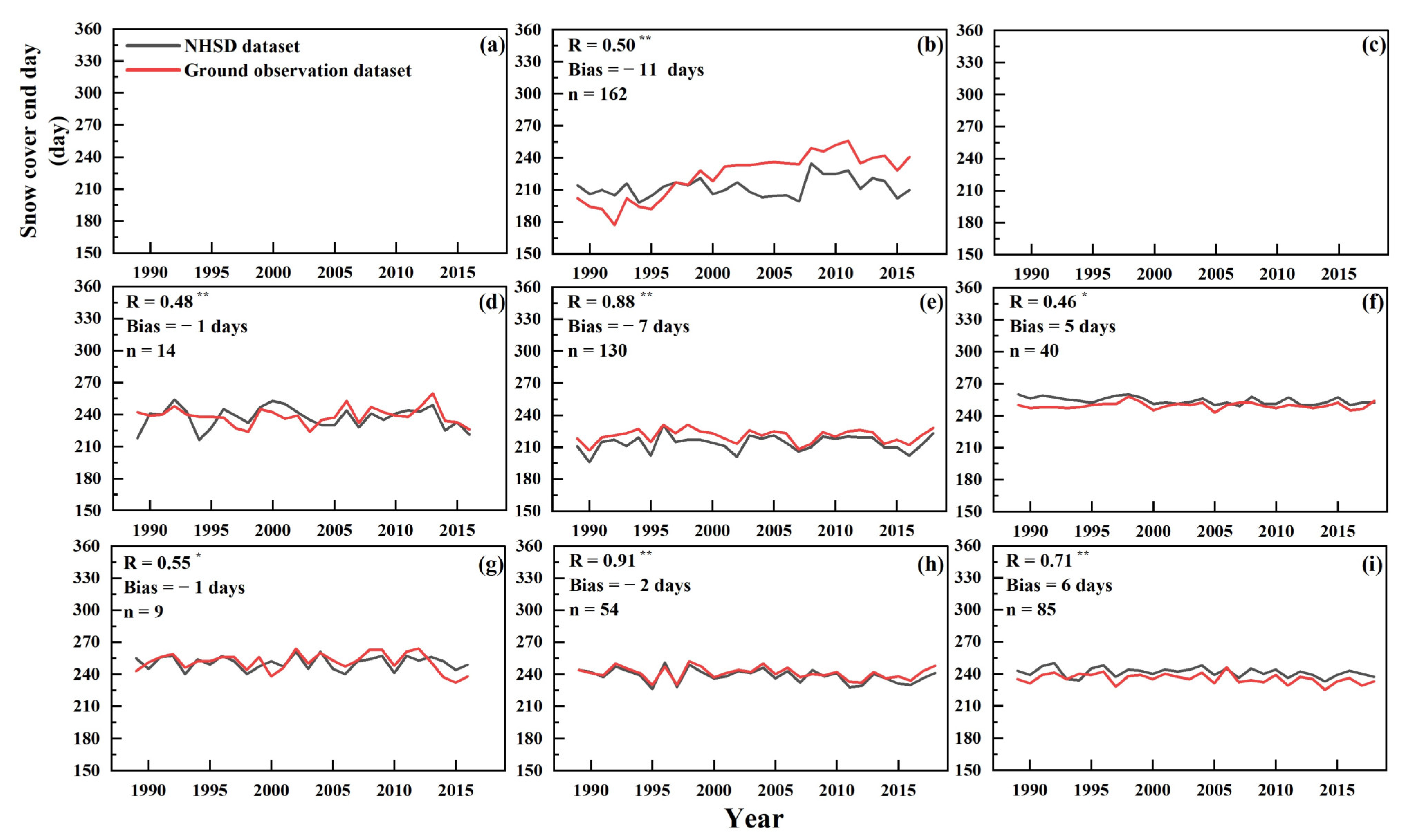
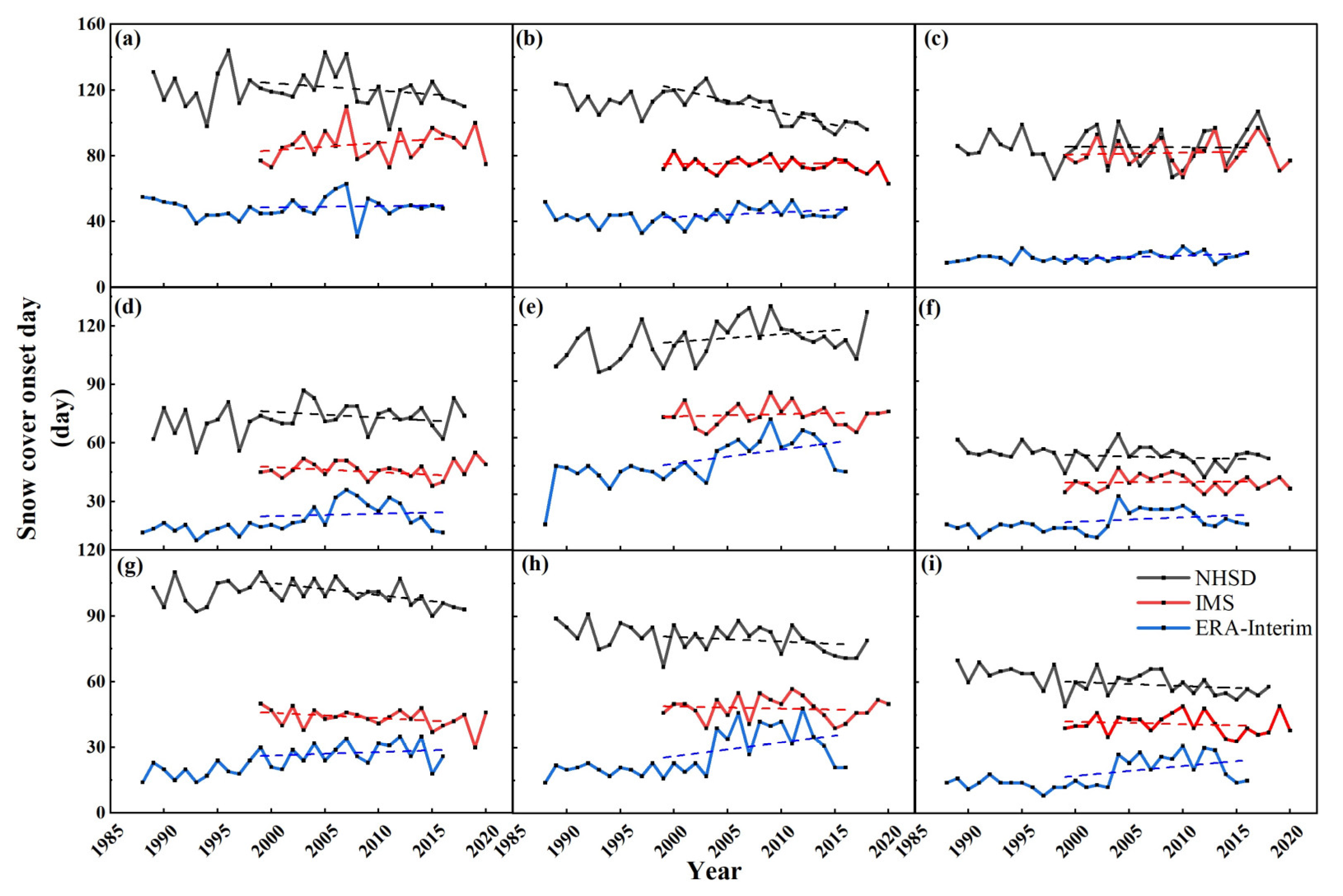
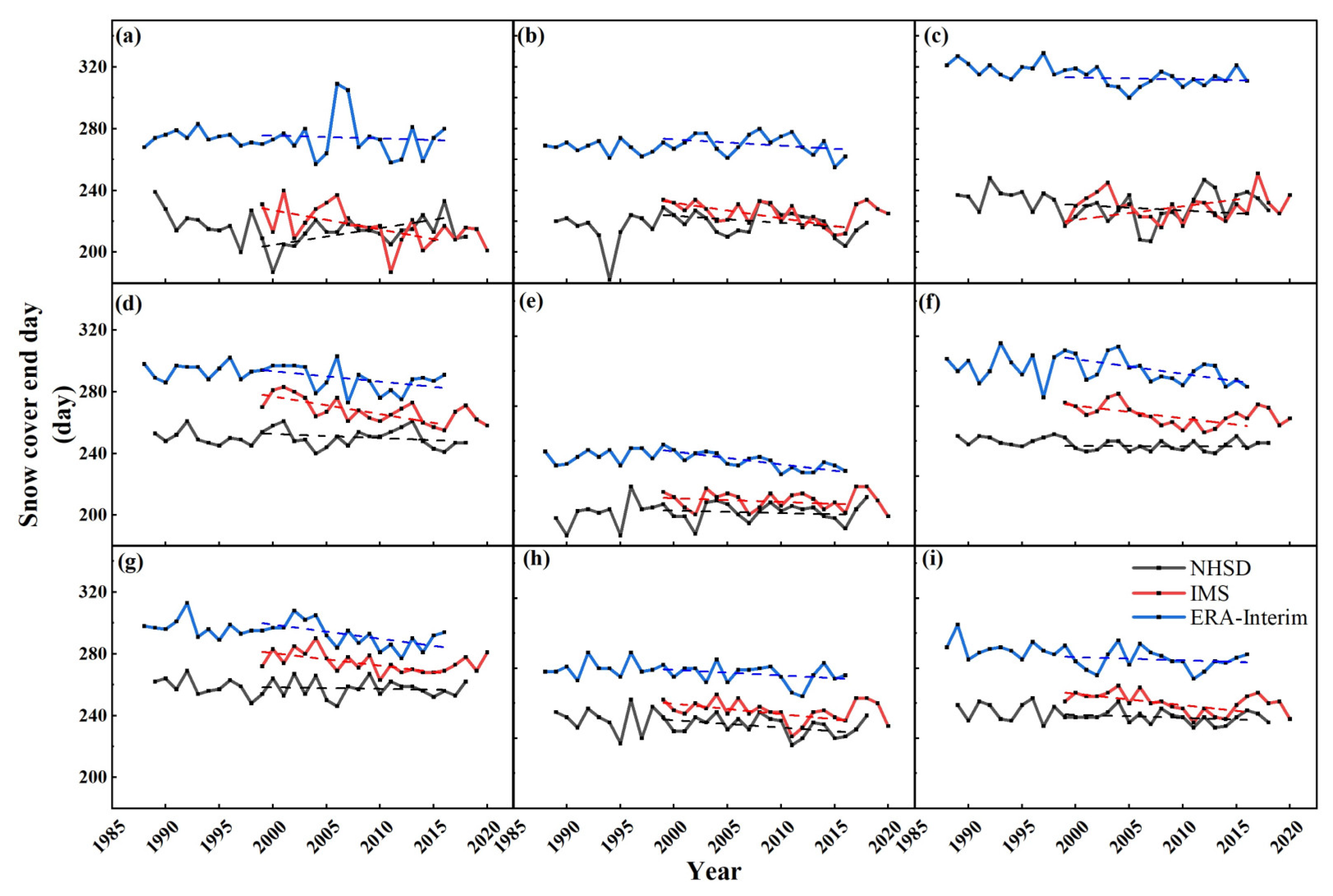
| Typical Area | Number |
|---|---|
| Alps | 1 |
| Rocky Mountains | 162 |
| Qinghai–Tibet Plateau | 0 |
| Alaska | 14 |
| Eastern European Plain | 130 |
| Eastern Siberian Mountains | 40 |
| Northern Canada | 9 |
| West Siberian Plain | 54 |
| Central Siberian Plateau | 85 |
| Typical Area | SD (cm/a) | SCOD (Day/a) | SCED (Day/a) | SSL (Day/a) | SCD (Day/a) | |
|---|---|---|---|---|---|---|
| High altitudes | Alps | 0.013 | −0.210 | −0.183 | 0.033 | 0.519 ** |
| Rocky Mountains | 0.018 | −0.678 ** | 0.092 | 0.784 ** | 0.948 ** | |
| Qinghai–Tibet Plateau | −0.003 | 0.156 | −0.153 | −0.296 | −0.621 * | |
| High latitudes | Alaska | −0.348 ** | 0.215 | −0.100 | −0.323 | −0.267 |
| Eastern European Plain | −0.229 ** | 0.466 * | 0.104 | −0.349 | −0.325 | |
| Eastern Siberian Mountains | 0.076 | −0.191 | −0.135 * | 0.052 | 0.115 | |
| Northern Canada | −0.300 ** | −0.184 | −0.119 | 0.061 | 0.197 | |
| West Siberian Plain | −0.090 | −0.302 * | −0.240 | 0.074 | 0.165 | |
| Central Siberian Plateau | −0.071 | −0.346 ** | −0.215 * | 0.142 | 0.384 * |
Publisher’s Note: MDPI stays neutral with regard to jurisdictional claims in published maps and institutional affiliations. |
© 2022 by the authors. Licensee MDPI, Basel, Switzerland. This article is an open access article distributed under the terms and conditions of the Creative Commons Attribution (CC BY) license (https://creativecommons.org/licenses/by/4.0/).
Share and Cite
Yue, S.; Che, T.; Dai, L.; Xiao, L.; Deng, J. Characteristics of Snow Depth and Snow Phenology in the High Latitudes and High Altitudes of the Northern Hemisphere from 1988 to 2018. Remote Sens. 2022, 14, 5057. https://doi.org/10.3390/rs14195057
Yue S, Che T, Dai L, Xiao L, Deng J. Characteristics of Snow Depth and Snow Phenology in the High Latitudes and High Altitudes of the Northern Hemisphere from 1988 to 2018. Remote Sensing. 2022; 14(19):5057. https://doi.org/10.3390/rs14195057
Chicago/Turabian StyleYue, Shanna, Tao Che, Liyun Dai, Lin Xiao, and Jie Deng. 2022. "Characteristics of Snow Depth and Snow Phenology in the High Latitudes and High Altitudes of the Northern Hemisphere from 1988 to 2018" Remote Sensing 14, no. 19: 5057. https://doi.org/10.3390/rs14195057
APA StyleYue, S., Che, T., Dai, L., Xiao, L., & Deng, J. (2022). Characteristics of Snow Depth and Snow Phenology in the High Latitudes and High Altitudes of the Northern Hemisphere from 1988 to 2018. Remote Sensing, 14(19), 5057. https://doi.org/10.3390/rs14195057






